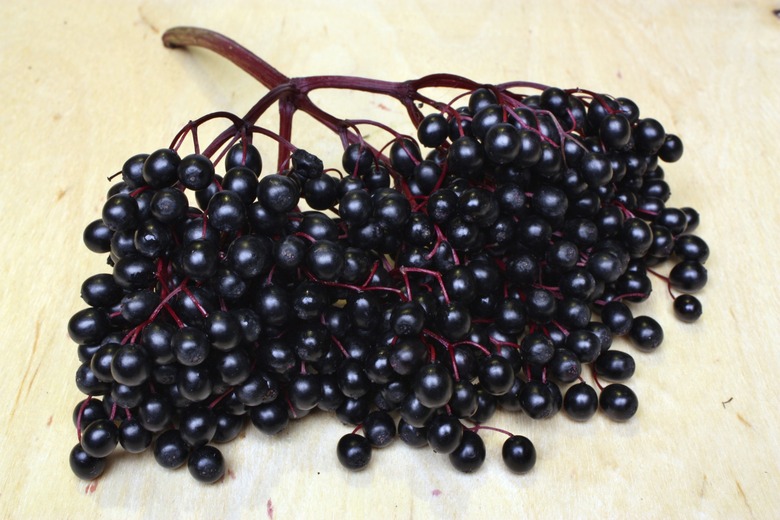How To Care For A Sambucus Black Lace Plant
Black-looking, deep-purple leaves give Sambucus Black Lace plant (Sambucus nigra "Eva" Black Lace), an elderberry, a dramatic appearance, and in late spring and summer, the visual effect is heightened when large clusters of tiny pink flowers stand out against the dark foliage. Though not particularly high-maintenance, well-timed care through the year keeps this shrub looking its best. Black Lace elderberry, grows in U.S. Department of Agriculture plant hardiness zones 4 through 7.
Step 1
Keep Black Lace elderberry looking lush through the growing season with regular watering. In spring and fall, water twice a week using 3 to 5 gallons of water each time. Step up watering to three times a week in summer and cut back to once a week in the winter. Water slowly, soaking the soil from the base of the trunk to the area 2 feet outside the branch tips.
Feed Annually
Step 1
Once a year, in early spring, use a slow-release tree and shrub fertilizer. A 6- to 8-foot-tall mature Black Lace elderberry needs 6 to 8 tablespoons of fertilizer per year. Sprinkle the fertilizer evenly from the base of the trunk to the area 2 feet beyond the outer branch tips. Water after fertilizing.
Step 2
- Keep Black Lace elderberry looking lush through the growing season with regular watering.
- Water slowly, soaking the soil from the base of the trunk to the area 2 feet outside the branch tips.
Prune Seasonally
Step 1
When it comes to pruning, you have options with this elderberry cultivar. Rejuvenate leggy shrubs, cutting all the stalks down 1 to 2 inches above the soil line. To shape and control the general size, cut back new growth by 1 to 2 feet. If the overall shape and size works in the garden, tidy up Black Lace elderberry, pruning out the dead branches and anything that's broken. Early spring, before new buds open, is the best time to prune but if you miss the window, you can prune in fall after the flowers fade. Soak your pruning tools to sanitize them before and after trimming each shrub using 1 part bleach to 2 parts water. Soak the tools for five minutes, then rinse them with clean water. Allow the tools to dry completely before you store them.
Step 2
- When it comes to pruning, you have options with this elderberry cultivar.
- Soak your pruning tools to sanitize them before and after trimming each shrub using 1 part bleach to 2 parts water.
Replenish Mulch
Step 1
Regulate soil temperature, retain moisture and keep the weeds down with annual spring mulching. Use an organic material, like bark chips, pine needles, sawdust or shredded bark, and spread it from the base of the trunk — keeping it 2 to 4 inches away from the trunk — out to the area 2 feet beyond the outer branches of the elderberry. Add only enough material each year to keep the mulch layer 3 to 4 inches deep.
Check for Pests
Step 1
Keep Black Lace elderberry pest-free by checking for bugs weekly. Look for aphids, tiny green or brown winged insects, and spider mites, minuscule pale to orange-colored insects, once a week. Both aphids and spider mites feed in large groups on the undersides of leaves. When you find an infestation, start with a strong spray of water to knock them from the plant. If that fails, spray the problem areas once a week with ready-mixed insecticidal soap spray. Spray the insects directly until the area is saturated to the point of dripping.
Step 2
- Regulate soil temperature, retain moisture and keep the weeds down with annual spring mulching.
- Use an organic material, like bark chips, pine needles, sawdust or shredded bark, and spread it from the base of the trunk — keeping it 2 to 4 inches away from the trunk — out to the area 2 feet beyond the outer branches of the elderberry.
Mitigate Diseases
Step 1
Occasionally, Black Lace elderberry will suffer from powdery mildew, a powdery substance on the leaves, or leaf spots, dark spots that appear on the leaves. You can minimize the chance of disease by watering only at the base of the shrub, rather than the leaves, and by fertilizing only once a year. When signs of infection appear, cut off the diseased leaves or branches to minimize spread. When working with a diseased shrub, it's important to sanitize your shears as you go.
References
- Missouri Botanical Garden: Sambucus Nigra "Eva" Black Lace
- Monrovia: Black Lace Elderberry
- The Morton Arboretum: Mulching Trees and Shrubs
- North Carolina State University: A Gardeners Guide to Fertilizing Trees and Shrubs
- University of California Integrated Pest Management Online: Spider Mites
- Missouri Botanical Garden: Leaf Spot Diseases of Shade Trees and Ornamentals
